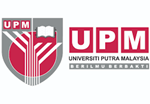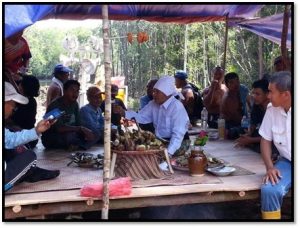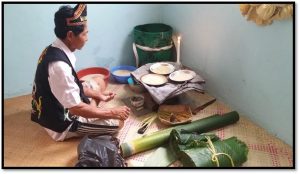Ritualism in Sarawak: A Case Study of Salako Tribe
Mohamad Maulana and Waseem
The Salako Tribe
Malaysia is a Southeast Asian country with Sarawak being the largest state of Malaysia located on Borneo Island. There are different tribes living on Borneo Island with distinct ethnic values and culture. Salako, classified as Bidayuh, is one of the most notable and renowned tribe of Sarawak. They speak Kendayan language and offer plenty of rituals to seek prosperity and wellbeing. Rituals are solemn practices ordained by the traditions of any community. It is important to study the rituals and their role on the way of living tribes. This article will analyse the ethnic history of the people of Sarawak as well as its influence on the entire society.
Rituals and symbols verbalize the community emotions, beliefs, values, traditions and behaviors. Such practices transferred to their next generations which embodies their imagination, psychological vision and social values. This article explores the culture of a Salako community that how religious rituals are performed with specific symbols in Sarawak ethnic areas. Salako or Selakau or Lara community can be found in Lundu area. Ethnicity basically influences the cultural values, beliefs and nature of a society. According to Salako tribe, world comprises of human beings and supernatural creatures such as the existence of spirits. A very strong notion about the existence of their God known as “Jubata” who is the guardian of their crops, health, land, water etc. This strong belief further demands a favorable reception from Jubata. To get insights into the rituals, direct verbal conservations are made with the natives. They narrate the rituals and traditions in an interview session that requires a lot of time. Salako community cultivate paddy rice for their survival and income like Malay community, Kadayan, Iban, Bidayuh and many others. Using the traditional ways to cultivate and harvest paddy rice, they still believe in supernatural powers and evil spirits. A ceremony has become tradition in remembrance of the paddy rice. This ritual is carried in two forms: A gathering ceremony for paddy fertility and a common ceremony for prosperity of life.
The Rituals and Traditions
Nyangahant-the mother of all rituals, refers to offering, praying or wish to Jubata before performing ceremonies like piercing of ear, marriage, birth, death and circumcision. The three elements that must be present in Nyangahant ritual are:
- performance item that is buis
- the ritual conductor known as Tuha Adat
- verses of Mantra.
These rituals must be executed after dawn and before noon. Tuha Adat has to seek permission from Jubata to start Mantra which is usually held at home for ease. To flutter the chicken on the head of person who wishes for something is the start of ceremony. There are many other foods based on the request of Jubata such as Manuk, boiled eggs, Poe’, Jungkahant, coconut oil, lime and tobacco as well as physical materials like apar, plates, jewelry etc. Pronunciation of Mantra in a right manner will fade away the coming difficulties. If not done correctly it will cause disaster. Several behaviors of Tuha Adat in Mantra include taking some food and tossing some food back. Putting meat of chicken or pig in odd figure can be wished for recovery from sickness. Greater the chicken or pig’s meat greater the Jubatas be invited by the Tuha Adat. For Manoh Manok ritual, the slaughtered chicken neck can’t be broken or cut. Cleaning the whole organs of chicken is the basic demand of Mantra, without cleaned liver Mantra can’t be completed. Even the blood of slaughtered chicken is to be prevented to spread everywhere as it is believed that blood is favored by Jinn and ghosts.
Tuha Adat acts like a bridge to contact with Jubata. A leader among the people is chosen as Tuha Adat who is well versed in rituals and holds highest position in society. They are selected by village community and passed down from generation to generation. According to them, Nyangahant ritual cannot be done easily because it involves supernatural powers. Therefore, selecting Tuha Adat it is not based on elections or consensus, but based on their position in the group. Moreover, tribal people also receive an epiphany via dreams in selecting the right person for Tuha Adat. It does not charge only in performance but also involves teaching younger generation about Salako community. This tradition may be unknown for younger generation, but it has become a guidance for its people since they are smaller in number.
Challenges of Traditional Perseverance
The long diverse and primitive history of rituals seems to be winding down gradually. The younger generation of Salako community does not show any commitment and interets to their ethnical roots. They also do not show interest in preserve their cultural treasures heritage and continuation of their primitive rituals. This is extremely worrying because it will lead to loss of endemic knowledge and rich heritage. Conservation efforts of ancient sacred places by authorities have also been receiving a cold response from Salako young community. On the other hand, the ethnical practices of Salako people need to be highlighted and promoted. The traditional role of rituals must be adapted to the needs of contemporary times and the young generation. This will ensure the continuity of tradition and cultural rituals.
For further information, you may contact
Associate Prof. Dr. Mohamad Maulana Bin Magiman
Universiti Putra Malaysia (UPMKB)
mdmaulana@upm.edu.my
Pehin Sri Adenan Satem Chair
The Pehin Sri Adenan Satem Chair (Kursi Tok Nan) has been established at Universiti Putra Malaysia Bintulu Campus (UPMKB), Sarawak, to spur research efforts and defend the unique identity and rich cultural heritage of Borneo at the international level. The establishment of the chair is a research joint venture between Universiti Putra Malaysia (UPM) and the Sarawak State Government through the Ministry of Tourism, Creative Industry & Performing Arts Sarawak
Disclaimer
The information featured and the presentation of material throughout this article do not imply the expression of any opinion whatsoever on the part of the Malaysian National Commission for UNESCO. The authors are responsible for the choice and the presentation of the facts contained in this article and for the opinions expressed therein, which are not necessarily those of Malaysian National Commission for UNESCO and do not commit the Commission.










